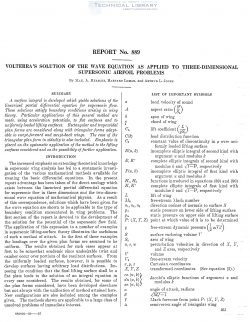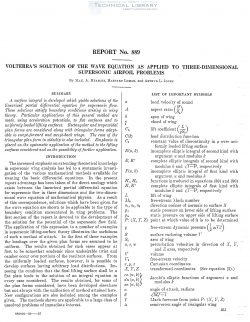naca-report-889

- Version
- 203 Downloads
- 1.70 MB File Size
- 1 File Count
- August 31, 2016 Create Date
- August 31, 2016 Last Updated
National Advisory Committee for Aeronautics, Report - Volterra's Solution of the Wave Equation as Applied to Three Dimensional Supersonic Airfoil Problems

A surface integral is dereloped which yields solutions of the
linearized partial differential eguation for supersonic flow.
These solutions satisfy boundary conditions arising in wing
theory. Particular applications of this general method are
made. using acceleration potentials, to flat surfaces and to
uniformly loaded lifting surfaces. Rectangular and trapezoidal
plan forms are considered along with triangular for-ms adapt—
able to swept—forward and swept-lac}: Mugs. The case of the
triangular plan form in sideslip is also included. Emphasis .is
placed on the systematic application of the method to the lifting
surfaces considered and on- the possibility offurther application.
The increased emphasis on extending theoretical knowledge
in supersonic wing analysis has led to a systematic investi—
gation of the various mathematical methods available for
treating the basic difi'erential equations. In the present
report advantage has been taken of the direct analogy which
exists between the linearized partial differential equation
for supersonic flow in three dimensions and the two-dimen-
sional wave equation of mathematical physics. As a result
of this correspondence, solutions which have been given for
the wave equation are shown to be applicable to the type of
boundary condition encountered in wing problems.
The first section of the report is devoted to the development of
the solution for the potential of the supersonic flow field.
The application of this expression to a number of examples
in supersonic lifting—surface theory illustrates the usefulness
of such a method of attack. In the first. of these examples
the loadings over the given plan forms are assumed to be
uniform. The results obtained for such cases appear at
first to be somewhat academic since undesirable twist and
camber occur over portions of the resultant surfaces. From
the uniformly loaded surfaces, however, it is possible to
develop surfaces having arbitrary load distributions.
| File | Action |
|---|---|
| naca-report-889 Volterra's Solution of the Wave Equation as Applied to Three Dimensional Supersonic Airfoil Problems.pdf | Download |

Comment On This Post